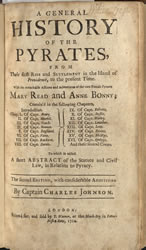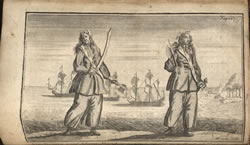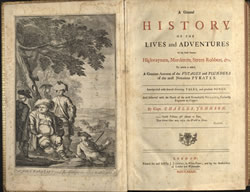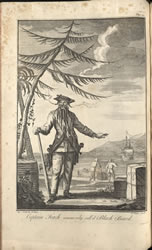
After the Treaty of Utrecht (1713), pirates were no longer openly supported in colonial ports. Some seamen turned to the growing slave trade, the Newfoundland fisheries, or settled down on land. A few continued to plunder, hoping for an eventual pardon or that they might find protection somewhere on the periphery of the empire as they had for almost a century before. They soon found little welcome anywhere, so they became increasingly desperate and maniacal. This lead to the brief but brutal period known as “the War on Pirates” (1716-1726), where we find some of the most colorful characters in early modern history, including Captain Teach (known as Blackbeard), Bartholomew Roberts (known as Black Bart), and the two female pirates, Anne Bonny and Mary Read.
Captain Charles Johnson’s General History of the Pyrates is the single most influential text on the image of piracy in popular culture. The mysterious author combined fact culled from trial records and newspaper accounts with fiction. Although it comprised only thirteen pages, the story of Anne Bonny and Mary Read was a major selling point. These two women were found guilty of piracy in Jamaica in 1721 but “pled their bellies,” claiming they were pregnant. Nonetheless, they were likely executed soon after.
Captain Teach, better known as Blackbeard, was a legendary scourge of colonial shipping. He held Charles Town, South Carolina siege for a chest of medicine. Johnson claimed Blackbeard consorted with the devil and that he tied matchsticks to the end of his twisted beard to make him look “like a frightful Meteor.” You might recognize this imagery in the figure of Davy Jones in the film Pirates of the Caribbean.






